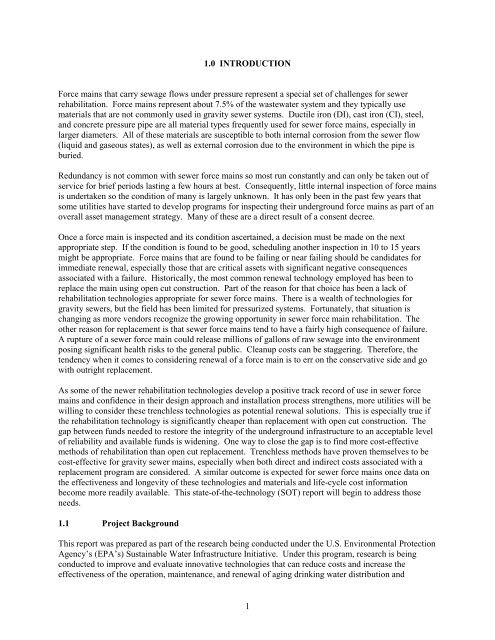State of Technology Report for Force Main Rehabilitation, Final ...
State of Technology Report for Force Main Rehabilitation, Final ...
State of Technology Report for Force Main Rehabilitation, Final ...
You also want an ePaper? Increase the reach of your titles
YUMPU automatically turns print PDFs into web optimized ePapers that Google loves.
1.0 INTRODUCTION<br />
<strong>Force</strong> mains that carry sewage flows under pressure represent a special set <strong>of</strong> challenges <strong>for</strong> sewer<br />
rehabilitation. <strong>Force</strong> mains represent about 7.5% <strong>of</strong> the wastewater system and they typically use<br />
materials that are not commonly used in gravity sewer systems. Ductile iron (DI), cast iron (CI), steel,<br />
and concrete pressure pipe are all material types frequently used <strong>for</strong> sewer <strong>for</strong>ce mains, especially in<br />
larger diameters. All <strong>of</strong> these materials are susceptible to both internal corrosion from the sewer flow<br />
(liquid and gaseous states), as well as external corrosion due to the environment in which the pipe is<br />
buried.<br />
Redundancy is not common with sewer <strong>for</strong>ce mains so most run constantly and can only be taken out <strong>of</strong><br />
service <strong>for</strong> brief periods lasting a few hours at best. Consequently, little internal inspection <strong>of</strong> <strong>for</strong>ce mains<br />
is undertaken so the condition <strong>of</strong> many is largely unknown. It has only been in the past few years that<br />
some utilities have started to develop programs <strong>for</strong> inspecting their underground <strong>for</strong>ce mains as part <strong>of</strong> an<br />
overall asset management strategy. Many <strong>of</strong> these are a direct result <strong>of</strong> a consent decree.<br />
Once a <strong>for</strong>ce main is inspected and its condition ascertained, a decision must be made on the next<br />
appropriate step. If the condition is found to be good, scheduling another inspection in 10 to 15 years<br />
might be appropriate. <strong>Force</strong> mains that are found to be failing or near failing should be candidates <strong>for</strong><br />
immediate renewal, especially those that are critical assets with significant negative consequences<br />
associated with a failure. Historically, the most common renewal technology employed has been to<br />
replace the main using open cut construction. Part <strong>of</strong> the reason <strong>for</strong> that choice has been a lack <strong>of</strong><br />
rehabilitation technologies appropriate <strong>for</strong> sewer <strong>for</strong>ce mains. There is a wealth <strong>of</strong> technologies <strong>for</strong><br />
gravity sewers, but the field has been limited <strong>for</strong> pressurized systems. Fortunately, that situation is<br />
changing as more vendors recognize the growing opportunity in sewer <strong>for</strong>ce main rehabilitation. The<br />
other reason <strong>for</strong> replacement is that sewer <strong>for</strong>ce mains tend to have a fairly high consequence <strong>of</strong> failure.<br />
A rupture <strong>of</strong> a sewer <strong>for</strong>ce main could release millions <strong>of</strong> gallons <strong>of</strong> raw sewage into the environment<br />
posing significant health risks to the general public. Cleanup costs can be staggering. There<strong>for</strong>e, the<br />
tendency when it comes to considering renewal <strong>of</strong> a <strong>for</strong>ce main is to err on the conservative side and go<br />
with outright replacement.<br />
As some <strong>of</strong> the newer rehabilitation technologies develop a positive track record <strong>of</strong> use in sewer <strong>for</strong>ce<br />
mains and confidence in their design approach and installation process strengthens, more utilities will be<br />
willing to consider these trenchless technologies as potential renewal solutions. This is especially true if<br />
the rehabilitation technology is significantly cheaper than replacement with open cut construction. The<br />
gap between funds needed to restore the integrity <strong>of</strong> the underground infrastructure to an acceptable level<br />
<strong>of</strong> reliability and available funds is widening. One way to close the gap is to find more cost-effective<br />
methods <strong>of</strong> rehabilitation than open cut replacement. Trenchless methods have proven themselves to be<br />
cost-effective <strong>for</strong> gravity sewer mains, especially when both direct and indirect costs associated with a<br />
replacement program are considered. A similar outcome is expected <strong>for</strong> sewer <strong>for</strong>ce mains once data on<br />
the effectiveness and longevity <strong>of</strong> these technologies and materials and life-cycle cost in<strong>for</strong>mation<br />
become more readily available. This state-<strong>of</strong>-the-technology (SOT) report will begin to address those<br />
needs.<br />
1.1<br />
Project Background<br />
This report was prepared as part <strong>of</strong> the research being conducted under the U.S. Environmental Protection<br />
Agency’s (EPA’s) Sustainable Water Infrastructure Initiative. Under this program, research is being<br />
conducted to improve and evaluate innovative technologies that can reduce costs and increase the<br />
effectiveness <strong>of</strong> the operation, maintenance, and renewal <strong>of</strong> aging drinking water distribution and<br />
1
















